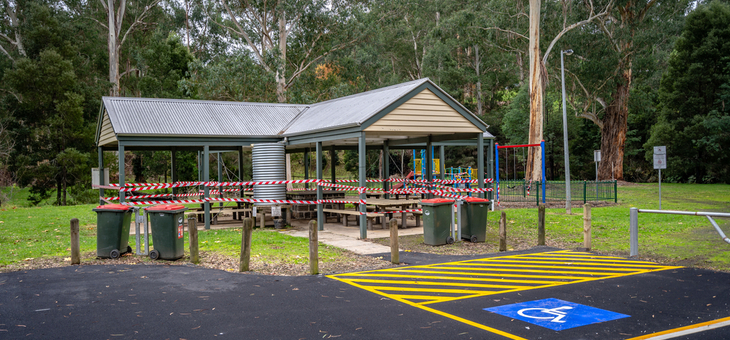Nearly a million Victorians in coronavirus hot spots face a return to extreme social restrictions if spiking case numbers do not abate.
Australia’s chief medical officer, Brendan Murphy, yesterday told the ABC the “strong advisory” from the Australian Health Protection Principal Committee (AHPPC) was for residents of those municipalities not to travel regionally or interstate.
On Sunday, Victorian premier Daniel Andrews mentioned locking down specific suburbs when announcing the scrapping of plans to ease coronavirus restrictions, saying the state was “absolutely at risk of a second peak”.
“It may be the case in the days ahead … where we have seen the data tells us a very clear story that there are extra cases and the highest number of cases, we may need to, for instance, reinstitute the stay-at-home (rule) …” he said.
That would mean residents of sanctioned regions would only be able to leave home for essential shopping, caregiving, exercise, or for study or work that cannot be done from home.
“We may need to go back to that setting in given geographical areas,” Mr Andrews said.
More than 83 per cent of new COVID-19 cases in Australia in the past seven days were recorded in Victoria.
This morning, residents and administrators of Hume, Casey, Brimbank, Moreland, Cardinia, and Darebin local government areas (LGA) took to talkback radio to express their dismay at being singled out.
But at a press conference just before noon, Victoria’s chief health officer, Brett Sutton, said the advisory was not a “lockdown”.
And Victoria’s health minister Jenny Mikakos said no new rules had been enacted.
“We have not issued stay-at-home directions for those hotspot areas but, of course, we don’t rule anything out. We are very concerned about the level of transmission in those particular locations,” Ms Mikakos said.
“I want to stress, just because you don’t live in a local government hotspot area does not mean that your area is without risk, and everybody should still be complying very closely with all of the public health advice.”
Professor Sutton, a member of the AHPPC, also urged residents of the six LGAs not to travel interstate.
“It is a pretty broad-brush description to talk about an LGA, obviously, and there are areas within those that are more of a concern,” Professor Sutton said.
“For the purpose of protecting our interstate we really need to say, look, reconsider travel or don’t make plans to travel into these hotspot areas, in particular, because it would be a very significant thing for there to be re-established community transmission in rural New South Wales.”
On Saturday, Professor Sutton said Victoria was “at a crossroads” with the disease.
“We are at a point where we have to turn it around or the numbers get beyond us.”
Victoria recorded 16 more cases of coronavirus in the past day, Ms Mikakos confirmed, after 19 new cases on Sunday, and 25 on Saturday. Those numbers were the highest in two months.
Ms Mikakos reminded all Victorians with symptoms to get tested and said people awaiting test results should not leave home.
From midnight on Sunday, until at least 12 July, household gatherings in Victoria will be limited to five guests and outdoor gatherings to 10 people.
Police minister Lisa Neville said police would increase enforcement of coronavirus measures, including issuing more fines and conducting more spot checks on people told to self-isolate.
The Age reports that the European Centre for Disease Control and Prevention rates as moderate to high the risk of a second wave of coronavirus big enough to require lockdowns being reimposed.
A report issued by the Grattan Institute on Sunday night says workplaces present the biggest risk of a second wave in Australia.
‘Coming out of COVID-19 lockdown: the next steps for Australian healthcare’ urges Australians to work from home for as long as possible.
“Workplaces should be reopened slowly, with as many people as possible continuing to work from home,” the report says. “Social distancing in workplaces is crucial and must continue to be incorporated into workplace reopening plans. Schools must be closed, and rigorous contact tracing implemented when a case is detected.”
Grattan Institute program director Stephen Duckett said: “We can’t be complacent when it comes to COVID-19. There is a real risk of a second wave.
“It’s dangerous for people to think this fight is over,” Dr Duckett said.
“The nature of the virus hasn’t changed – our behaviour has.
“If Australians go back to a pre-COVID normal, the virus could spread quickly and wildly, like it has elsewhere.”
The report suggests interstate borders remain shut until near elimination of the virus is achieved.
Do you supporting ‘locking down’ coronavirus hot spots?
If you enjoy our content, don’t keep it to yourself. Share our free eNews with your friends and encourage them to sign up.
Related articles:
https://www.yourlifechoices.com.au/health/covid19/covid19-intergenerational-war
https://www.yourlifechoices.com.au/health/covid19/expect-covid19-bill-shock-or-not
https://www.yourlifechoices.com.au/health/covid19/face-masks-better-than-handwashing

